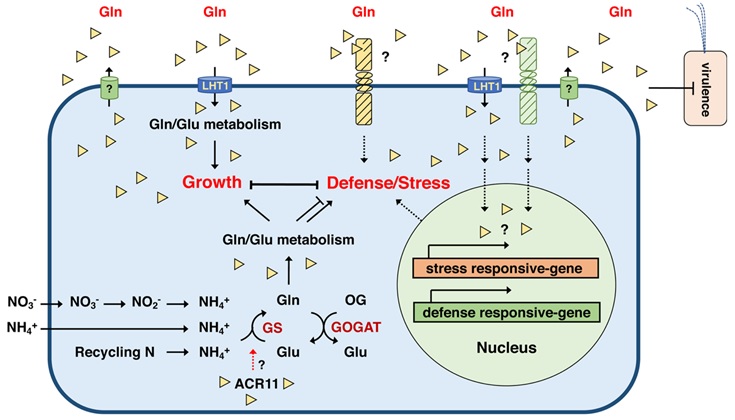
The Earth’s ecological environment is intricately linked to our lives. Plants play a vital role in the ecosystem, indispensable in maintaining life and ecological balance on our planet. In addition to providing food and oxygen, plants can regulate and safeguard the entire ecosystem. Despite our extensive understanding of plants, many mysteries surround how they coordinate growth, metabolism, and defense responses. In the pursuit of unraveling these enigmas, glutamine (Gln) has emerged as a subject of scientific investigation.
🪢Why Do Scientists Study Gln?
Gln, an amino acid for protein synthesis, is an essential molecule in all living organisms. Gln is the most abundant free amino acid in humans and a nitrogen carrier to peripheral tissues and internal organs. It is estimated that Gln content corresponds to 50–60% of free amino acids in the skeletal muscle. Beyond protein synthesis and serving as a metabolic fuel, Gln is vital in immune systems and cancer cells.
Similarly, scientists have also uncovered Gln’s significant roles in plant metabolism, immunity, and defense responses. Exploring the functions of Gln helps us grasp plants growth, development, defense mechanisms, and how they utilize nitrogen to maintain growth and metabolism. These studies have practical applications in agriculture and food security, as they may provide improved cultivation techniques and methods to cope with environmental stresses and climate change.
🪢What is Gln in Plant Physiology?
Gln is a nitrogen donor for essential biomolecules in the cell. The primary nitrogen sources for plants are NH4+ or NO3– in the soil. These inorganic nitrogen compounds undergo nitrogen assimilation within plant cells, eventually transforming into Gln through Gln synthetase (GS), where NH4+ and glutamate (Glu) are converted into Gln. Gln is the first organic nitrogen synthesized in the cell. Nearly all organic nitrogen compounds in the cells are derived from Gln. Besides its role as a building block for protein synthesis, Gln is a nitrogen donor for synthesizing amino acids, nucleic acids, amino sugars, and vitamins B1, B3, and B9.
Gln is an energy source for plants. When plants require energy, Gln can be catabolized into Glu and NH4+. Glu is then metabolized to α-ketoglutarate, entering the tricarboxylic acid (TCA) cycle to produce energy-rich molecules like ATP. ATP, an energy currency within cells, is a molecule for energy storage and transfer, participating in various physiological and biochemical reactions. The energy derived from Gln may play a vital role in sustaining normal physiological activities in plants.
🪢What functions does Gln serve in plants?
1. Promoting Growth and Development:
Gln is a building block for protein synthesis. Plant cells continuously divide and form new tissues during growth and development, requiring ample amino acids and protein support.
2. Synthesis of Amino Acids and Other Biomolecules:
Gln is required for the biosynthesis of amino acids, nucleic acids, amino sugars, and B-group vitamins. Some of these biomolecules are essential metabolites, while others play regulatory or intermediary roles in metabolism, maintaining normal physiological activities in plants.
3. Defense Responses:
Gln is a signaling molecule in plant defense. Recent research indicates that Gln has an unexpected role in inducing plant immune and defense responses. Gln can enhance disease resistance against pathogen infection in plants.
4. Stress Adaptation:
Gln metabolism and signaling modulate plant adaptation to environmental stresses. Adverse environments, such as heat, cold, and drought, greatly impact plant growth and development. In such situations, plants can readjust the synthesis and distribution of Gln, enhancing their resilience to cope with diverse environmental challenges.
【Extensive Reading】
Dr. Ming-Hsiun Hsieh’s laboratory at the Institute of Plant and Microbial Biology, Academia Sinica, recently published a review paper and proposed a working model for Gln-induced plant growth and defense. Gln is an amino acid for protein synthesis, a metabolic fuel for growth and development, and a signaling molecule for plant defense responses.
Reference:
Kim-Teng Lee, Hong-Sheng Liao, Ming-Hsiun Hsieh*
(2023) Glutamine Metabolism, Sensing and Signaling in Plants
https://doi.org/10.1093/pcp/pcad054

🪢Future Prospects: Exploring the Further Marvels of Gln
Gln is an essential primary metabolite for plant growth and development. Propelled by the knowledge of plant metabolism and the advancement of biotechnology, scientists have successfully used genetic engineering to alter plant metabolic pathways, creating crops with enhanced yields and resilience against adversities. Gln metabolism and signaling play a vital role in the immune system in humans. Scientists also gradually recognize Gln’s impact on plant immunity and defense responses.
Plant biologists will conduct more in-depth research into Gln, unraveling its physiological functions and molecular mechanisms. They will actively seek more effective ways to harness Gln to improve crop yields and quality. Particularly, delving further into the roles of Gln in plant growth and defense will contribute to the development of sustainable agriculture in the future.
